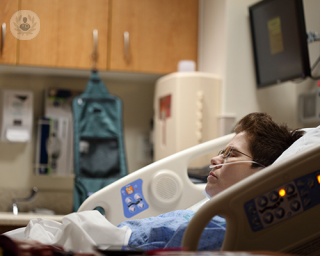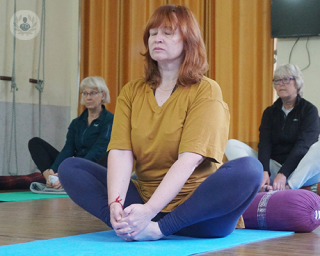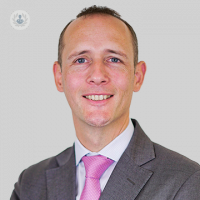What is DIEP flap reconstruction?
Women who have a mastectomy performed as part of breast cancer treatment may later decide to have reconstructive surgery to rebuild the breast which was removed. DIEP (deep inferior epigastric perforator) flap reconstruction is a type of reconstructive breast surgery which uses tissue taken from the patient’s abdomen.

Why is it done?
DIEP flap reconstruction is done in order to reconstruct the breast which was removed during mastectomy. While there are many reconstructive procedures available nowadays, with different surgical techniques producing different results, the DIEP flap reconstruction procedure can offer a natural-looking and feeling breast, as it uses the patient’s own tissue.
Implants can sometimes produce an uneven result, as of course the implanted breast may look slightly different to the natural breast, and implants can also distort and be uncomfortable years after the initial surgery. DIEP flap reconstruction rarely requires significant retouching, and the result is both natural and ‘softer’ looking, as the reconstruction should age naturally along with the patient, and change depending on your weight.
DIEP reconstruction can also be used to improve the appearance of the breast and relieve symptoms of a tight or distorted implant.
The result of DIEP flap surgery is generally lifelong, although occasionally a second smaller operation is needed after the initial one, to adjust the reconstruction, or to remake the nipple.
What does it involve?
The procedure is performed under general anaesthetic, using microsurgery to disconnect some of the tissue and blood vessels from the lower abdominal area. Once the ‘flap’ of tissue has been removed, it can be connected to a new blood supply in the chest. The operation itself is complex and can take between 6 to 8 hours. As it is performed under general anaesthetic, you should expect to be in the hospital for several days.
How do you prepare for DIEP flap surgery?
Your surgeon will assess if you are eligible for DIEP flap surgery, as those who are underweight or significantly overweight may not be considered for the procedure. If you have enough spare tissue around the abdomen, you may be able to have DIEP flap surgery. In your consultations with your surgeon, they will discuss the options available to you, and if you decide to choose DIEP flap surgery, you will have a CT angiogram performed.
A CT angiogram checks the blood vessels in the abdomen and can tell the surgeon if any type of injury to the abdominal muscle is likely to happen during surgery. Other tests may be ordered to check you are suitable for surgery.
Aftercare
As the procedure is relatively complex, you will have to stay in hospital for a few days after surgery. A scar, similar to that of an abdominoplasty, sits on the abdominal area, but this generally fades well over time. Scarring on the breast depends on the surgery performed. If the procedure is performed at the same time as the initial mastectomy, scarring can be reduced. If performed at a later date, the scar may be a little more visible, but it generally fades well over time too.
After surgery, you will need to avoid strenuous activity for around 6 weeks and some discomfort may be felt in the abdomen for this time. You can expect to be back to normal after about three months.
Alternatives to this treatment
Various forms of reconstructive surgery can be performed after a mastectomy, including implant surgery, where an implant filled with saline, silicone gel, or a mixture of the two is used to reconstruct the breast. Tissue can also be taken from other areas of the body in similar ‘flap’ procedures, such as from the thigh or back. Your plastic surgeon will explain your options and you can decide on the best course of action after exploring them together.
10-06-2017 09-20-2023DIEP breast reconstruction
Mr Kieran Power - Plastic surgery
Created on: 10-06-2017
Updated on: 09-20-2023
Edited by: Aoife Maguire
What is DIEP flap reconstruction?
Women who have a mastectomy performed as part of breast cancer treatment may later decide to have reconstructive surgery to rebuild the breast which was removed. DIEP (deep inferior epigastric perforator) flap reconstruction is a type of reconstructive breast surgery which uses tissue taken from the patient’s abdomen.

Why is it done?
DIEP flap reconstruction is done in order to reconstruct the breast which was removed during mastectomy. While there are many reconstructive procedures available nowadays, with different surgical techniques producing different results, the DIEP flap reconstruction procedure can offer a natural-looking and feeling breast, as it uses the patient’s own tissue.
Implants can sometimes produce an uneven result, as of course the implanted breast may look slightly different to the natural breast, and implants can also distort and be uncomfortable years after the initial surgery. DIEP flap reconstruction rarely requires significant retouching, and the result is both natural and ‘softer’ looking, as the reconstruction should age naturally along with the patient, and change depending on your weight.
DIEP reconstruction can also be used to improve the appearance of the breast and relieve symptoms of a tight or distorted implant.
The result of DIEP flap surgery is generally lifelong, although occasionally a second smaller operation is needed after the initial one, to adjust the reconstruction, or to remake the nipple.
What does it involve?
The procedure is performed under general anaesthetic, using microsurgery to disconnect some of the tissue and blood vessels from the lower abdominal area. Once the ‘flap’ of tissue has been removed, it can be connected to a new blood supply in the chest. The operation itself is complex and can take between 6 to 8 hours. As it is performed under general anaesthetic, you should expect to be in the hospital for several days.
How do you prepare for DIEP flap surgery?
Your surgeon will assess if you are eligible for DIEP flap surgery, as those who are underweight or significantly overweight may not be considered for the procedure. If you have enough spare tissue around the abdomen, you may be able to have DIEP flap surgery. In your consultations with your surgeon, they will discuss the options available to you, and if you decide to choose DIEP flap surgery, you will have a CT angiogram performed.
A CT angiogram checks the blood vessels in the abdomen and can tell the surgeon if any type of injury to the abdominal muscle is likely to happen during surgery. Other tests may be ordered to check you are suitable for surgery.
Aftercare
As the procedure is relatively complex, you will have to stay in hospital for a few days after surgery. A scar, similar to that of an abdominoplasty, sits on the abdominal area, but this generally fades well over time. Scarring on the breast depends on the surgery performed. If the procedure is performed at the same time as the initial mastectomy, scarring can be reduced. If performed at a later date, the scar may be a little more visible, but it generally fades well over time too.
After surgery, you will need to avoid strenuous activity for around 6 weeks and some discomfort may be felt in the abdomen for this time. You can expect to be back to normal after about three months.
Alternatives to this treatment
Various forms of reconstructive surgery can be performed after a mastectomy, including implant surgery, where an implant filled with saline, silicone gel, or a mixture of the two is used to reconstruct the breast. Tissue can also be taken from other areas of the body in similar ‘flap’ procedures, such as from the thigh or back. Your plastic surgeon will explain your options and you can decide on the best course of action after exploring them together.


Is DIEP flap the breast reconstruction method for you?
By Mr Paul Roblin
2024-11-21
The DEIP flap procedure is the most commonly performed breast reconstruction using a patient's own tissue. To help you understand if the DIEP flap method is the right one for you, Mr Paul Roblin provides you with a comprehensive overview of the procedure, what to look for in a surgeon, advantages and disadvantages as well as alternatives. See more


What happens before, during and after DIEP flap breast reconstruction surgery?
By Mr Kelvin Ramsey
2024-11-21
DIEP flap breast reconstruction is an alternative procedure to breast implants and is becoming a popular choice for women who have had a mastectomy. Mr Kelvin Ramsey, top plastic surgeon, explains what happens before the procedure, on the day of surgery and after surgery. See more


Recovery and potential complications of DIEP flap breast reconstruction surgery
By Mr Kelvin Ramsey
2024-11-20
DIEP flap breast reconstruction surgery is proving popular among women because of its pleasing visual results and longer-term benefits. Mr Kelvin Ramsey, top plastic surgeron, discusses the recovery period and potential complications to be aware of. See more


What is DIEP flap breast reconstruction and is it right for me?
By Mr Kelvin Ramsey
2024-11-20
DIEP flap breast reconstruction can offer more natural looking and feeling breasts than implants. Leading plastic surgeon Mr Kelvin Ramsey talks us through the procedure and its advantages. See more
Experts in DIEP breast reconstruction
-
Mr Kieran Power
Plastic surgeryExpert in:
- Breast surgery
- Body contouring
- DIEP breast reconstruction
- Tummy tuck (abdominoplasty)
- Skin cancer
- Breast reconstruction
-
Mr Paul Harris
Plastic surgeryExpert in:
- Breast reduction
- Breast augmentation
- Breast lift or mastopexy
- Breast implant removal surgery
- Gynaecomastia
- DIEP breast reconstruction
-
Mr Damir Kosutic
Plastic surgeryExpert in:
- DIEP breast reconstruction
- Lymphoedema
- Skin cancer
- Migraine
- Liposuction
- Tummy tuck (abdominoplasty)
-
Mr Adam Blackburn
Plastic surgeryExpert in:
- Breast reduction
- DIEP breast reconstruction
- Breast lift or mastopexy
- Breast fat transfer
- Skin cancer
- Tummy tuck (abdominoplasty)
-
Professor Charles Malata
Plastic surgeryExpert in:
- Breast augmentation
- Breast reduction
- Tummy tuck (abdominoplasty)
- Rhinoplasty (nose job)
- Facelift
- DIEP breast reconstruction
- See all

The Christie Private Care - part of HCA Healthcare
The Christie Private Care - part of HCA Healthcare
Wilmslow Rd, Withington, Manchester
No existe teléfono en el centro.
By using the telephone number provided by TOP DOCTORS, you automatically agree to let us use your phone number for statistical and commercial purposes. For further information, read our Privacy Policy
Top Doctors

The Lister Hospital - part of HCA Healthcare
The Lister Hospital - part of HCA Healthcare
Chelsea Bridge Road, London
No existe teléfono en el centro.
By using the telephone number provided by TOP DOCTORS, you automatically agree to let us use your phone number for statistical and commercial purposes. For further information, read our Privacy Policy
Top Doctors

Specialists in Plastic Surgery
Specialists in Plastic Surgery
5 Devonshire Place
No existe teléfono en el centro.
By using the telephone number provided by TOP DOCTORS, you automatically agree to let us use your phone number for statistical and commercial purposes. For further information, read our Privacy Policy
Top Doctors
-
The Christie Private Care - part of HCA Healthcare
Wilmslow Rd, Withington, Manchester , ManchesterExpert in:
- Brachytherapy
- Cancer
- Stem cells
- Cancer surgery
- Robotic Surgery
- Cancer screening clinic
-
The Lister Hospital - part of HCA Healthcare
Chelsea Bridge Road, London , Central LondonExpert in:
- Cancer
- Cardiology
- Orthopaedic surgery
- Pregnancy
- Physiotherapy
- Women’s health
-
Specialists in Plastic Surgery
5 Devonshire Place, W1G Marylebone LondonExpert in:
- Abdominoplasty
- Blepharoplasty
- Breast augmentation
- Facelift
- Liposuction
- Breast reduction
- See all
- Most viewed diseases, medical tests, and treatments
- Migraine
- Head and neck cancer
- Neck lump
- Acellular dermal matrix (ADM)
- Prepectoral breast reconstruction
- One Stop Breast Clinic
- Botulinum toxin (Botox™)
- FUE hair transplant
- Carpal tunnel syndrome
- Anti-ageing treatments







